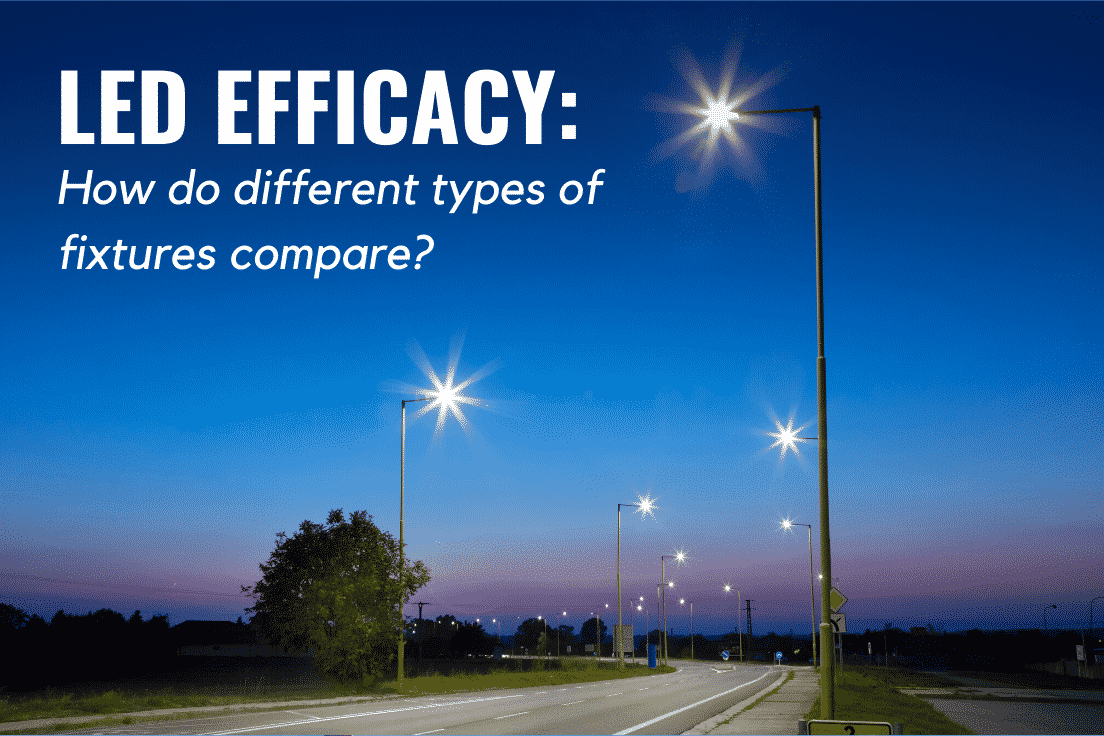How much value are you getting from your lighting? That depends, in part, on the fixture’s efficacy. Technically, efficacy means lumens divided by watts: the higher the efficacy of a fixture, the more light it will produce with a lower wattage, which saves energy on a per watt basis.
You might also wonder how different fixtures compare in their efficacy. While it is true that the technology for all LED lighting is improving–and so the efficacy of all fixtures is also improving–certain kinds of fixtures are more efficacious than others. Let’s explore what this means.
Efficacy for High Lights, such as Parking Lot Lights and Warehouse High Bays
Consider tall lights that are placed far from the surface, such as parking lot lights or warehouse high bays. Just a few years ago, you might have replaced a common 400 watt fixture with a 140 LED light fixture. But because the efficacy is quickly improving, that same fixture can now be replaced with a 120 watt LED fixture or sometimes even a 100 watt LED fixture. This results in up to a 40-watt savings per fixture. If this light is one of many in a car lot, this will mean a lot of money (and energy) saved over the course of a year.
Efficacy for Low Lights, such as Indoor Office Fixtures
Indoor, traditional-height lighting has also had improved efficacy recently. Take a common kind of older indoor office lighting, a 4-foot fluorescent light, as an example. This light typically has a 30-32 watt bulb and is replaced with a 4-foot LED 2 fixture, which has a 12-15 watt LED tube. This more efficient energy will result in a lot of savings over the year.
The shape and construction of the fixture itself have an impact on the efficacy of that fixture. You might notice that there is a bit less efficacy for indoor tube lighting than for some other kinds of lighting. This is in part because there is not much aluminum in the tube fixtures, as they are primarily made out of glass, and aluminum housing is the most efficient way to disperse heat.
This kind of fixture contrasts with other kinds of lights, such as high bay fixtures. High bay fixtures are more efficacious for two reasons: first, they are made out of solid aluminum, and this helps to disperse the heat. Second, the driver is now separated from the aluminum housing to provide greater airflow and to increase the efficacy rate.
Efficacy for Retrofitted Fixtures
When updating lighting, sometimes it’s possible to use the existing fixtures and put in LED lighting. This is called retrofitting fixtures. Although it’s possible to do this, should you?
Most LED experts will caution against retrofitting the fixtures, primarily because retrofitting will negatively impact the efficacy of the fixture, no matter what kind of fixture it is. This is because the heat of the fixture will be trapped in the older housing and will not be able to be dispersed, causing wear and tear on the driver and, eventually, on the quality of the color temperature.
While retrofitting fixtures can be a cheaper option in the short run, it costs more in the long run because of the inefficiency of the original fixture. Also, changing the entire fixture comes with a 10-year warranty on the lighting compared to just a 5-year warranty on retrofitted lighting.
To ensure the greatest longevity of the lighting and the highest return on investment, replacing the entire fixture is the best option. Although the initial cost will be higher, the long-term costs will be lower, and some rebates may apply which will help to lower the initial costs.
No matter the fixture, LED lighting is becoming even more energy efficient, and that’s good news for everyone.

